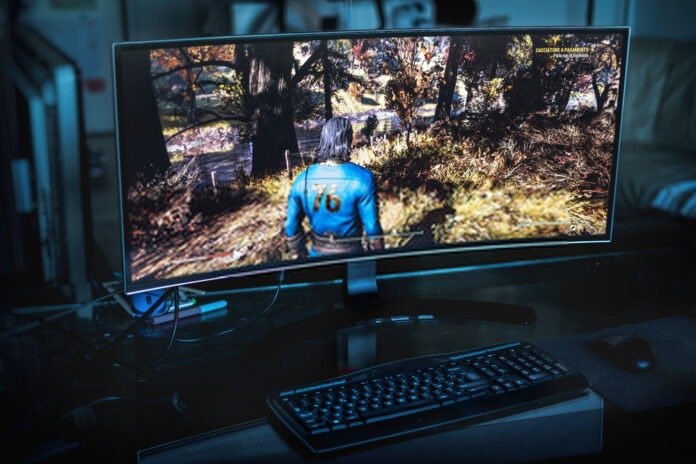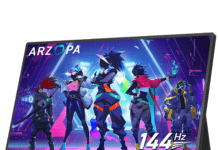Have you decided to invest in an extra large screen to see bigger? You are in the right place ! Find our selection of the 5 best Ultrawide screens, a buying guide to guide you and frequently asked questions to answer your questions.
What to know before buying an ultrawide screen!
Extra wide screens are as their name suggests: wide. So make sure you have enough space on your desk to install it.
- Due to their large size, some Ultrawide screens are curved which will give you the impression of being totally immersed in what you are doing. Once you have tasted curved PC screens you will not be able to do without them.
- As you can imagine your budget should be more substantial than for a normal screen. However, you will have a greater immersive experience
Comparison of the best Ultrawide screens of this year
1. The Samsung C49RG90, an extra-large curved screen that dominates
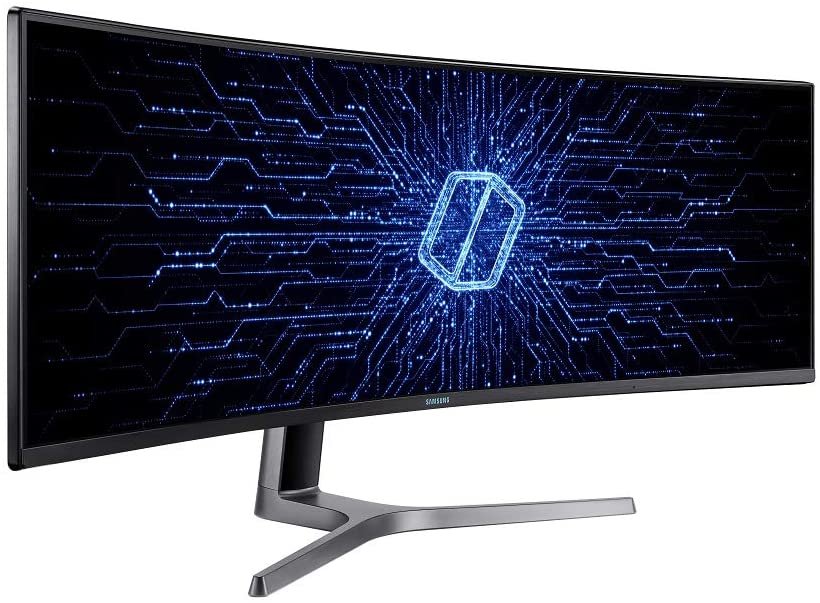
We start our comparison with the best of the best from Samsung. This 49-inch ultra-wide curved LCD screen is perfect for obtaining an unparalleled field of vision in most setups. With a display resolution of 5120 x 1440 pixels (5K) and a refresh rate of 120 Hz you will be able to enjoy exceptional vision of your multitasking programs or your favorite video games. HDR 1000 and AMD FreeSync technologies will allow the first to reach a brightness of 1000 nits and the second to synchronize images to avoid any tearing and stuttering. With its response rate of 4 milliseconds, nothing will escape you.
Benefits :
- 49'' curved screen for optimal vision
- Ultra HD in 5K
- Good response rate at 4 milliseconds
- HDR 1000 for brightness and AMD FreeSync for synchronization
Disadvantages:
- Its high price
2. The Millenium MD49, a borderless screen for e-sports
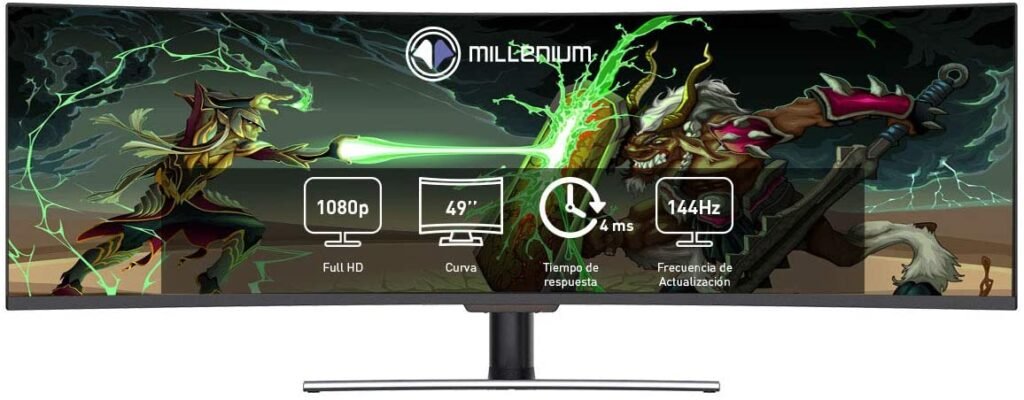
If you are a hardcore gamer and want an ultrawide screen for online gaming, the Millenium MD49 is the curved PC monitor for you. Designed and developed by players participating in e-Sport competitions, the MD49 meets all the criteria for playing in the best conditions. With a borderless frame and its curved profile, you will be able to concentrate 100% in your game while minimizing distractions as much as possible. Its refresh rate of 144 Hz and response time of 4 milliseconds will give you maximum performance when combined with AMD FreeSync and Nvidia G-Sync technology. The MD49 is undoubtedly a 4K PC monitor for gamers .
Benefits :
- Created for gamers
- Ultra -fine screen borders
- 144 Hz for perfect in-game fluidity
- FreeSync and G-Sync compatible
Disadvantages:
- Brightness which sometimes be quite weak
3. The LG Ultrawide 35WN73A-B, a QHD screen for professionals

If you are looking for an extra large PC screen to work and increase your productivity this ultrawide LG is for you. Offering 33% additional workspace compared to a 16: 9, this QHD 3440 x 1440 39 -inch screen is perfect for managing the multitasking with several windows open simultaneously. No need to use Alt + Tab! The 100 Hz cooling rate gives a more fluid impression of images and the HDR screen including 99% of SRGB colors will offer spectacular renderings. The Onscreen Control software will allow you to personalize your workspace according to your needs in just a few clicks. Finally, the USB Type-C at the back of the monitor gives the possibility of connecting your latest generation devices such as a laptop or your smartphone.
Benefits :
- Perfect for professionals
- But also suits gamers
- Simplified multitasking management thanks to the onescreen control
- AMD Freesync and Dynamic Action Sync Compatible for image synchronization
- USB Type-C port
Disadvantages:
- Quite heavy therefore provide a solid arm if you want to fix it on the wall
4. Millenium MD34Pro, a 34 '' curved, lively and cut for competition

The Millennium MD34Pro is like its compatriot a curved pc to gamer. Smaller than the MD49, it is however faster . Indeed its response rate is 1 millisecond for an ultra fast reaction action. Combined with its 144 Hz in refreshing rate, the MD34Pro ensures a fluid performance and gaming experience at its maximum. The curved Qled screen and its minimized edges will dive into the heart of the action. So opt for this model from Millenium if your budget does not allow you to offer yourself the MD49, you will lose in screen size but will gain in responsiveness.
Benefits :
- Perfect for gamers
- Ultra fast response rate to 1 milliseconde
- High refresh rate at 144 Hz
- A curved Qled screen with viewing angle at 178/178
Inconvenience :
- No real drawbacks
5. The Samsung S34J550Wqu, an ultrawid flat screen with energy saving

If you do not want a curved screen this ultrawide PC screen model from Samsung is a very good choice! Its resolution of 3440 x 1440 in HD in 21: 9 format with a 75 Hz refreshment rate are less efficient than the other screens of this comparison but they remain a safe bet for gamers and professionals. Where this Samsung model is distinguished is at the level of energy saving and visual comfort . The first advantage comes from an automatic adjustment of the brightness of the screen compared to that ambient, reducing up to 10% consumption (50% maximum with manual adjustment). The second is facilitated thanks to Eye Saver technology, reducing blue light emissions .
Benefits :
- Energy savings
- Reduction of blue light
- Fluidification of images thanks to the Flicker Free Samsung
Disadvantages:
- Only 75 Hz
- The smallest of our selection (34 inches)
The purchasing criteria for choosing your Ultrawide PC screen!

Use its use
The first thing to do before choosing an ultrawid screen is to determine what will be its main use. Some screens are more suitable for working while others are designed in order to play. Although there is not a abyss of differences, there are some. It's up to you to choose by following our guide in a guide (yes yes it is possible!).
An extra large screen to play
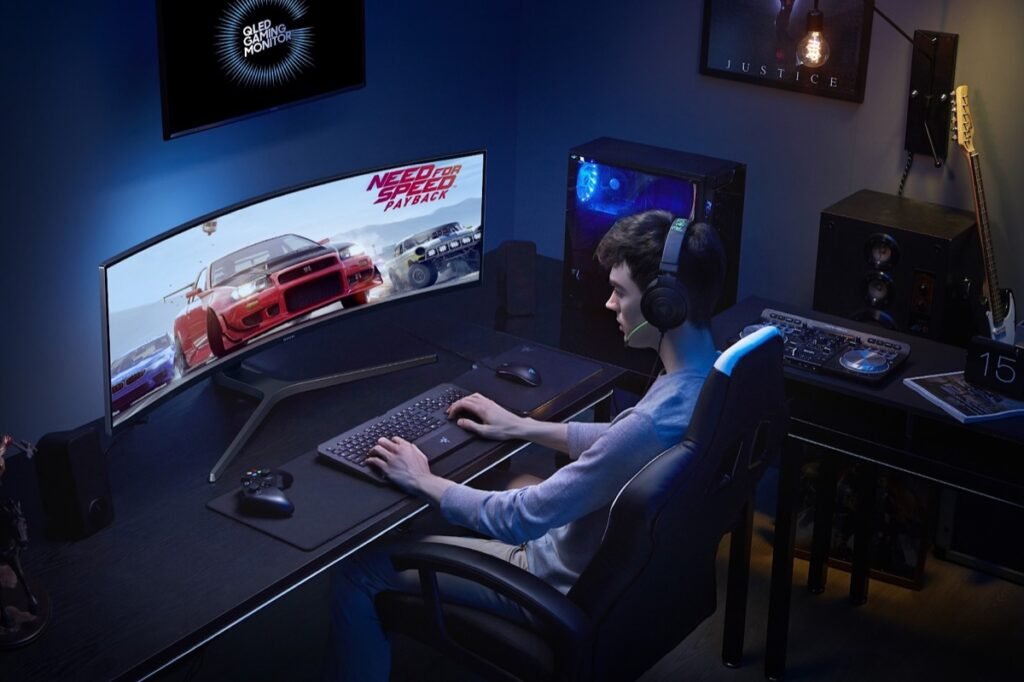
More and more gamers are looking for ultrawide screens to have a lot of information at the same time, because more information means advantages over your opponents. They therefore opt for a curved screen offering several decisive advantages when playing video games.
The refresh rate
In order to get the most out of it and aim for performance, you must choose an extra large screen with the least response time possible as well as a high refresh rate .
The first determines the latency time between the information transmitted by your components and the display on your screen. In general, ultrawides offer one within 5 milliseconds which is sufficient .
The second characteristic determines the number of images updated per second on your screen. A minimum of 75 Hz is recommended for gaming but you will see a huge difference with a 144 Hz PC monitor .
Good to know: If you are looking for a 240 Hz PC screen in Ultrawide, you may be disappointed... The best you can find at the moment is a 27 inch screen with the Samsung Odyssey.
It will also be necessary to take into account the G-Sync and Freesync function from NVIDIA or AMD. They make it possible to synchronize your frequency of refreshment to your FPS and are therefore necessary not to undergo deformed images.
To enjoy a panoramic view!
Another advantage of having an ultrawid screen for gaming is improving the field of vision, or Field of View (FOV). Of course, to take advantage of it, a condition is essential! This is that your game allows a customizable configuration, fortunately the majority of modern games have this option. This functionality gives FPS players a more important vision on the sides , offering them the possibility of identifying enemies more easily.
In a strategy game or MOBA you will have a larger surface area of the terrain visible at the same time, perfect for effectively coordinating an attack or spotting troops flanking (understanding attacking on one side). This panoramic view will give you advantages over your opponents no matter your game!
Total immersion!
The third asset is the immersion so much sought after by some gamers to completely immerse themselves in their game. It is obvious that it is easier to feel fully on a 10 '' screen than a 50 '', but having it in flat screen will not be more immersive than a curved screen of 39 ''. The curved models have the distinction of being bent on the sides to allow the spectator to see the whole screen without having to move their eyes . Better vision with a minimum of effort in short.
Our recommended points in brief for a gaming configuration:
- Curved screen
- Minimum 75 Hz in refreshment rate
- Maximum 5 milliseconds in response time (1 millisecond recommended)
- G-SYNC and/or FREESYNC functionality (s)
An ultra -wide screen to work
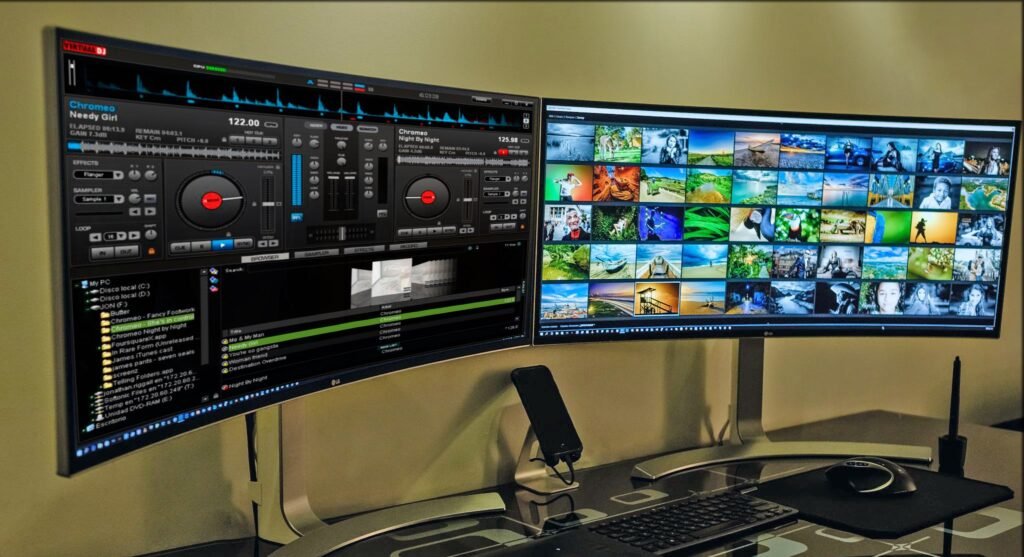
If you want to work with more comfort, a wide screen is the solution you need. Here are some reasons that should convince you:
+ comfort and productivity gain
You will first gain in productivity. In fact, you will be able to more easily manage the multitasking of your applications in order to switch from one to the other more quickly. No need to use ALT + TAB, you will have everything in front of you, at the same time . Some manufacturers even offer predefined settings to place windows in predetermined locations. These settings are perfect for quickly organizing your workspace. For example, if you are working on the presentation of a company's next balance sheet, you can display the PowerPoint presentation, an Excel workbook and OneNote to have all the information simultaneously. Even having two windows open will save you time and be more readable than on a small screen.
Stunning resolution and image quality!
You will get sharper image resolution . You will be able to enjoy very good quality resolution on an ultrawide screen because they have a much higher definition than small screens. While 16:9 is around Full HD (1920 x 1080), the vast majority of ultra-wide screens are compatible with a resolution of 3440 x 1440 pixels, which offer much higher definition. This resolution corresponds to the number of pixels that the screen has, the more it has, the more numerous and precise the details will be. This feature is very important for people doing graphics or video editing.
Better image quality. As with the pixel resolution, the quality of the panel is very important for the image profession. To learn more, refer to the following points on “screen quality differences”.
Our recommended points in brief for an ultrawide screen dedicated to work:
- A wide screen with few borders if possible and a window organization manager
- A high image resolution for more details (think about the refresh rate)
- High image quality
An ultrawide screen for entertainment

Ultrawide screens are also perfect for watching films or series. If you are looking for this type of screen to enjoy your favorite films and series alone, as a couple or as a family, pay attention to these 3 criteria when making your choice.
Image quality is the most important thing when looking at entertainment. So take into account the image resolution in order to display a clear and detailed image. So go to a 4K screen and with a quality slab .
Good to know : If you are looking for a screen with unrivaled image quality but smaller than an ultra-wide screen, a transportable 4K monitor will be a great asset to you! Essential if you need a dual screen for your laptop or to play the console anywhere!
A 21: 9 format will make the black bands disappear at the top and bottom when you watch your films, shot in a similar format to be broadcast in the cinema. This effect of black bands, called letterbox, appears on smaller image formats like the 16: 9 or 4: 3 in order to respect the original cinematographic format without distorting or reframing the image.
On the other hand, since the series are mostly shot in 16:9, you will probably have black bands on the sides with a 21:9, this is the Pillarbox effect.
Think about the G-Sync and FreeSync functions which will be able to correctly synchronize images and avoid seeing 3 films in one.
Choose your screen with as little border as possible to make the most of the screen size.
Our recommended points in brief for an entertainment screen:
- A 4K screen
- G-Sync or Freesync functions
- If possible little border
Differences in screen quality
There are several acronyms to determine the quality of an ultrawide monitor. Designating a number of pixels , they are not 100% indicative of the quality of the image because the size of the screen also plays a role. The smaller the screen, the greater the pixel density which will result in higher image quality, however the number of pixels is generally adjusted to obtain better results. A brief overview of the different terms.
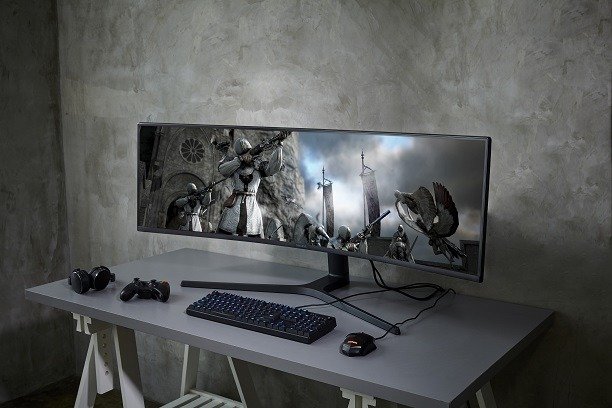
HD – High Definition
This term designates a pixel size of 1280 x 720, regardless of the screen size as long as this proportion is respected. The majority of smartphones today use HD screens. This definition is used more on small screens.
FHD – Full High Definition
Full HD corresponds to a definition of 1920 x 1080, this definition type is present in a large part of screens 16: 9.
QHD – Quad HD or 2K
Here we go into detail, since this term designates a screen having 4 times more pixels than an HD screen. QHD screens have a resolution of 2560 x 1440 pixels to provide the viewer with a detailed image, and therefore of very good quality.
UHD – Ultra HD and 4K
These screens have even better image quality. The first has a resolution of 3860 x 2160 pixels and the second 4096 x 2160. Many of the best 4K ultrawide PC screens have a resolution of 4096 x 2160, in order to provide the sharpest image possible without being able to distinguish the pixels.
8K
This is the final phase of the definition which is 16 times higher than the HD standard. With its 7680 x 4320 pixels , the precision is ultra realistic and your images will have nothing to hide from you…
The advantages of a curved screen
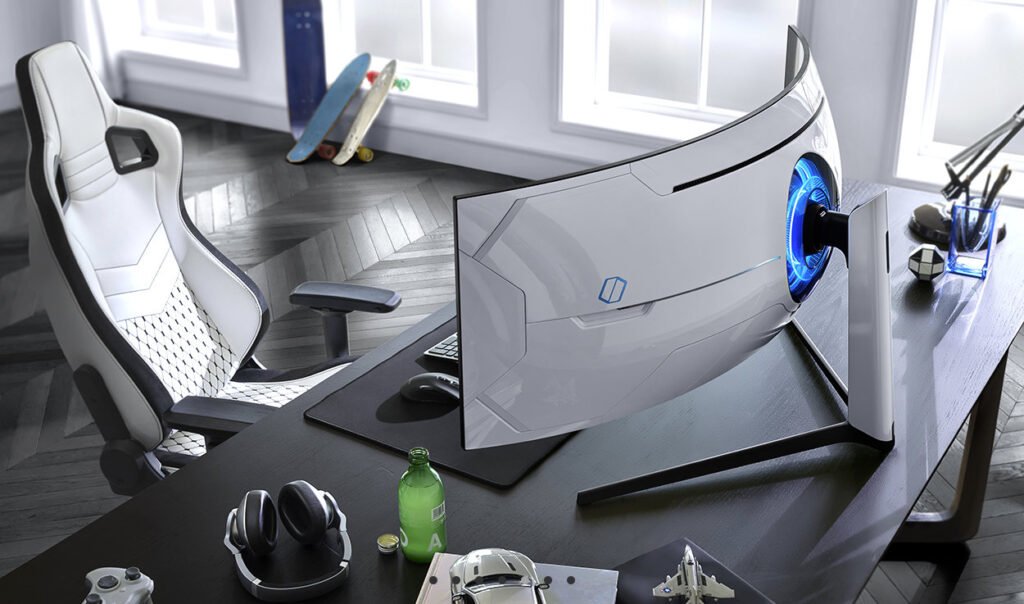
There are several advantages to using a curved screen. Overview :
The curved screen does not distort the image
The wider an ultrawide screen is, the more difficult it is to see the edges of its screen correctly. You therefore lose visibility and details may escape you. The curved screen allows you to overcome this problem. With its curved design, you will be able to more easily distinguish the edges of your screen since the system will automatically adjust the image depending on the angle.
But it is not only the automatic adjustment of the image which justifies that curved screens allow better vision: it is mainly physical. Indeed, the projection of light being in a straight line on a flat screen, that of a curved screen projects the light directly towards the viewer. It therefore receives all the images directly in front of it, thus avoiding distortion.
The curved screen is much more immersive
More and more spectators are looking for an immersive experience to live and feel 100% of what they are seeing. This type of experience has started to be offered in cinemas, larger screens plunged into darkness offering a focused view of what is happening.
With the appearance of the VR helmet (or virtual reality headset), it is possible to be completely immersed in what you are seeing. It is this immersive experience that the ultrawid screens curled up, by offering the visitor an extended peripheral vision in order to see only what is happening on the screen.
You'll feel more immersed in the movies you watch or the video games you play.

Curved ultrawide screen provides a wider field of vision
In addition to this immersive experience, curved screens have a much wider field of vision than flat screens. This feature comes from the fact that a flat screen the same size as a curved screen will have distorted edges. Plus your eyes won't have to move between each side to see what's going on, since the optimal field of vision covers the entire size of the ultrawide curved screen.
The curved screen is more comfortable for your eyes
With a curved screen, your natural field of vision will be more adapted and fill the entire size of the screen. To do this you will need to position yourself at the distance corresponding to the curvature of your screen. For example, if your ultra-wide curved screen has a 178° curve, you will need to position yourself 17.8 cm from it to optimize your field of vision. It will then take up the full width to give you a complete view of your screen.
Good to know: We invite you to see our comparison on curved screens for PC to find out more!
Check G-Sync and FreeSync compatibility
In order to enjoy your ultrawide screen in the best conditions, you will need at least one of the technologies offered by Nvidia or AMD . G-Sync and FreeSync will vertically adapt and synchronize the images broadcast on your screen.
To use these features, you will need a graphics card from one of the manufacturers, otherwise this feature will be useless to you. The first thing to check is therefore to choose your screen according to your graphics card or vice versa. With this warning out of the way, let’s look at the benefits of these features.
Prevent Tearing
Tearing or tearing of images is a problem that occurs when the number of images per second (the famous FPS or Frame Per Second) calculated by the graphics card is not synchronized nor a multiple of the refresh rate (Hz) of your screen. This results in multiple images being displayed that are not synchronized in time and space.
Taking the example of a football match during a goalkeeper clearance, the upper part of the screen will display the corner stands of the stadium, the part in the middle of the screen the central circle of the field and the part bottom of the screen between the repair zone and the central circle. Difficult to follow a match in these conditions... G-Sync and FreeSync prevent these malfunctions in the images by synchronizing the frequency of the monitor to the FPS.
Adapts against Stuttering
This synchronization goes even further since it can adapt depending on the game you are playing. Stuttering corresponds to microsaccades of images which are duplicated to continually display them on the screen. When looking at a screen suffering from Stuttering you will have a feeling of jerky images from this display and therefore an impression of lag. To resolve this problem, G-Sync and FreeSync automatically adapt their refresh rate to that of the GPU.
This process will take place when your game requires too powerful resources from your gaming PC for it to be able to achieve FPS at the refresh rate of your ultrawide screen. The latter will then lower its frequency to match the FPS and thus correctly display the images.
Additional options
Much of the screens manufacturers offer their users additional features in order to personalize their experience. These options are specific to the brand or the product range. Indeed an ultra -wide high -end screen will have more functionality than a low -end screen. Here are some types of additional options offered by manufacturers.
Integrated adjustment programs
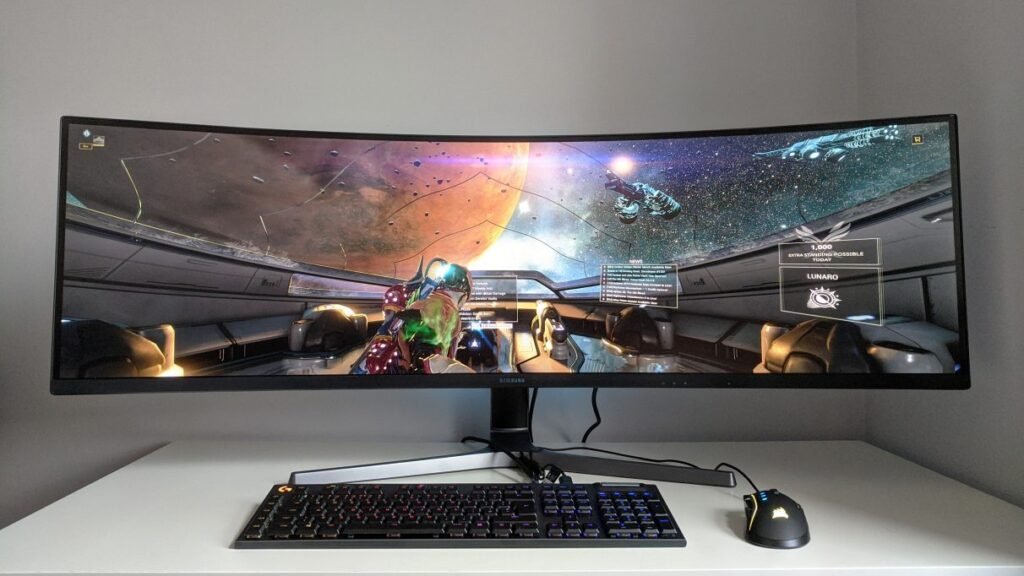
Programs are installed there to adjust every detail such as colors, brightness, contrasts and even speaker volume. Some even offer configurable profiles that will launch depending on the application used. This option is particularly useful if you have chosen different settings between watching a movie and playing your favorite game.
Ultrawide displays replacing dual displays that are typically used to handle multiple tasks at once. For example, write code on one and see the result on the other. Programs offer quick and easy management for this type of display where you simply select a window layout on your screen: 2 windows side by side, 2 windows on top of each other, 3 windows with a large one at the top and 2 small ones at the bottom, etc…
Comfort options
To improve the comfort of its users, manufacturers integrate dedicated settings into their screens. This is particularly the case with the ultrawide Samsung S24F350FHU screen integrating energy saving technology and a display mode reducing blue lights. The first will automatically settle the brightness according to the one where your screen is located, it will drop if darkness is detected so as not to dazzle yourself and consequently its energy consumption.
According to Samsung, it can be reduced by 10% with this automatic function but can be reduced by 50% with manual settings. The second integrated setting is Eye Saver mode which reduces blue light emission to provide better comfort and less visual fatigue.
FAQ—Find out all the details about Ultrawide displays
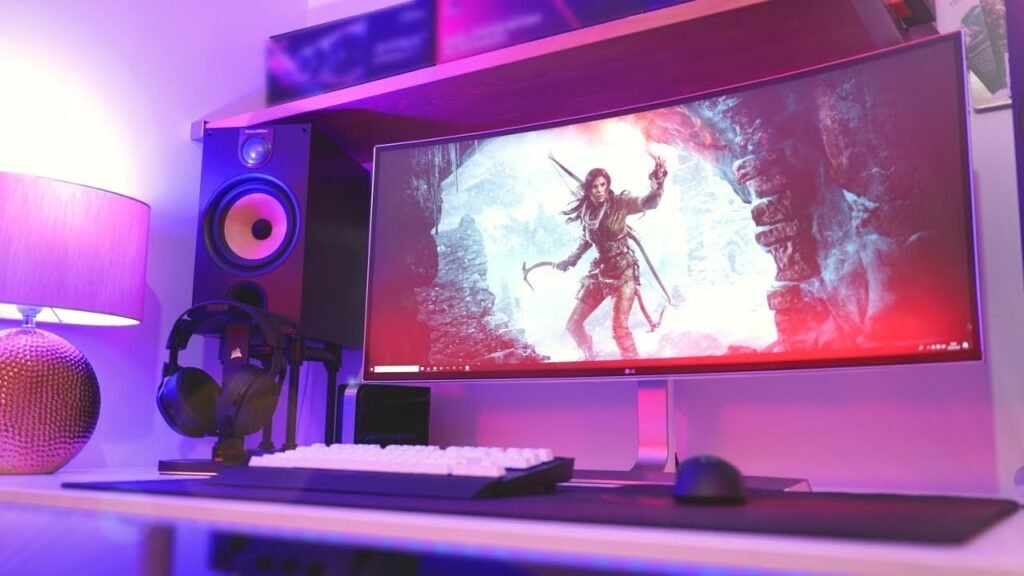
What are the differences between a 100 Hz, 144 Hz and 240 Hz screen?
Hz designates the rate (or frequency) of image refreshment. The higher this rate, the more fluid and comfortable your image is to look because the scan made by your screen will be more important. It is greatly linked to the images in seconds with the difference that it will also sometimes display the same images again to ensure which stick to the previous ones.
A frequency of 100 Hz is sufficient to be able to play your favorite games since 75 Hz is the minimum recommended frequency.
A 144Hz screen will already create a huge difference when you look at your screen. Your fluidity will be much improved than on a 100 Hz screen, and you will be able to play with complete peace of mind. This frequency is generally chosen by demanding players to enjoy more demanding games.
Finally, a 240 Hz screen will push all limits. Only intended for gamers who do not want to compromise on their gaming experience, screens with this rate are similar to reality in terms of fluidity. If you are moving towards this type of screen, your configuration must be able to hold up.
Why buy an ultrawide screen?
It is sometimes said that size does not matter, but an exception can be made with ultrawide screens. If you want to play with high definition as well as total immersion, ultra-wide screens are for you. Likewise, if you are a professional and need high-end equipment, you will gain productivity with this type of screen.
These are the 34'' which are the most common and comfortable . With a diagonal of 86 cm, you will have enough space to do what you like. If, however, this does not seem enough to you, and if you have the space, you can accommodate a 49'' on your desk, with a gigantic diagonal of 124 cm. Enough to impress your visitors, if you always welcome them with such a jewel.
How important is the response rate?
The response rate is very important since it defines the reaction speed of your screen, that is to say the speed at which a pixel will change color. Typically, response rates are around 4 to 5 milliseconds but can be reduced to 1 millisecond on some screens. The lower the response rate, the smoother the images displayed will appear to you .
What is HDR?
HDR or High Dynamic Range was once only used in photography. It is a technology that allows you to display greater brightness with better contrasts. Indeed, an HDR screen will be able to process greater brightness but also deeper blacks.
Whatever the exposure of the image, HDR will be able to display particularly bright areas in detail and delineate shadow areas in order to get as close as possible to human sight.
For the best minimum experience, we advise you to opt for an ultrawide screen with a brightness of at least 1000 nits and less than 0.03 nits for black.

